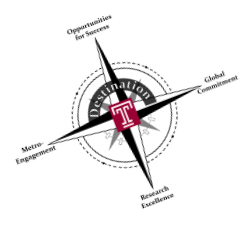Academic Strategic Compass debuts
| After 18 months of collaboration — a process that pooled the collective insight of hundreds of faculty members, administrators and students — Temple Provost and Senior Vice President for Academic Affairs Lisa Staiano-Coico announced the public debut of the university's Academic Strategic Compass.
This week, the Office of the Provost posted an executive summary of the Academic Compass (the new name of the initiative once known as the Academic Strategic Plan) at www.temple.edu/provost/
|
 A visual representation of the Academic Strategic Compass
|
|
"I'm grateful for the hard work, imagination and emotional investment that our faculty, staff and students have poured into the Academic Compass," Staiano-Coico said. "Temple has entered a defining moment in the university's history. The changing higher-ed landscape and the challenges of the current financial picture demand a new direction for Temple to advance in the academic world, while at the same time being true to our heritage. That's what the Academic Compass is intended to provide — a tool to help us map our destiny." Like a compass rose on a nautical chart, the Academic Compass is organized into four cardinal directions — "Opportunities for Success," "Global Commitment," "Research Excellence," and "Metro-Engagement" — emerging from a central point, called "Destination Temple." At the Academic Compass web site, visitors can find lists of strategies, initiatives, outcome measures and progress to date for each of the five points on the compass rose. Dozens of specific initiatives are outlined, many with ambitious five-year goals. Select highlights include increasing the six-year graduation rate from 59 to 70 percent (from "Opportunities for Success"), increasing financial aid from 12.5 to 14.5 percent of annual tuition generated ("Opportunities for Success"), increasing sponsored research by 50 percent (from "Research Excellence") and achieving the Carnegie Community Engagement classification (from "Metro-Engagement"). Staiano-Coico said that the Academic Compass has evolved in recent months as she and her staff embarked on a plan to visit each of Temple's schools and colleges for discussions with faculty. "This is an organic process," said Staiano-Coico, who noted that the Academic Compass web site includes sections dedicated to sharing opinions and suggestions. "The Academic Compass isn't something that emerged overnight, written on stone tablets. Yes, the guiding principles that emerged out of the planning process are fixed. But the Academic Compass is a product of collaboration — it will continue to change as our discussions with Temple stakeholders move forward. And, of course, it will adapt to the shifting economic terrain." Staiano-Coico also stressed that Academic Compass initiatives were developed with the cascading effects of the economic downturn in mind. "With families under stress, we must work harder than ever to maintain Temple's tradition of access," Staiano-Coico said. "To keep Temple affordable, we've made significant budget cuts. The Academic Compass's initiatives, although ambitious, are designed to fit into the university's budget plans without passing any costs on to our students." The public launch of the Academic Compass's executive summary and inventory of initiatives is the next step in the development of a comprehensive strategic plan that will guide Temple over the next five years. The Academic Compass's initiatives will be merged into strategic plans for the university's finances and facilities. |
|